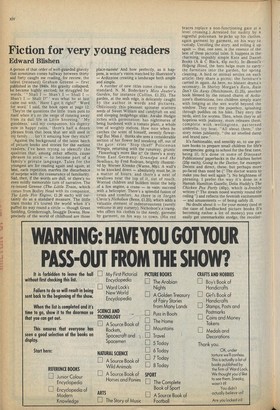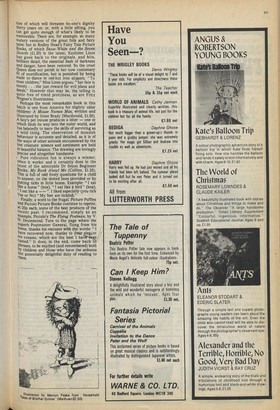Fiction for very young readers
Edward Blishen
A person of that order of well-guarded gravity that sometimes comes halfway between thirty and forty caught me reading, for review, the latest (reissued) Graham Greene — first published in the 1940s. His gravity collapsed; he became highly excited; he struggled for words. " Shall I — Shan't I — Shall I — Shan't 1 — Shall I?" ' was what he at last came out with. 'Have I .got it right?' 'Word, for word.' I said, the book open at page 12. They're the questions the little train puts to itself when it's on the verge of running away from its dull life in Little Snoreing." My goodness,' said my companion, his dignity now in happy ruins, 'there's half a dozen phrases from that book that are still used in my family ... Isn't it amazing how they stick!'
Against the background of the latest batch of picture books and stories for the earliest readers, I've been trying to identify the qualities that, among other effects, cause phrases to stick — to become part of a family's private language. Tales for the youngest are for reading again and again; at best, each repetition marries the disturbance of surprise with the reassurance of familiarity. Sad, then, if the words are dull, or there's no even mildly memorable turn of narrative. The re-issued Greene (The Little Train, which comes from Bodley Head with its companion, The Little Fire Engine, e1.20 each) will certainly do as a standard measure. The little train thinks it's toured the world when it's
10 puffed its way round a circle — though Great Scolding, Grimborough, Snuggle Downs. How precisely of the world of childhood are those
place-names! And how perfectly, as it happens, is writer's vision matched by illustrator's — Ardizzone creating 'a landscape both ample and simple. A number of new titles come, close to this standard. N. M. Bodecker's Miss Jaster's Garden, for instance (Collins, £1.25). The garden, at the sea's edge, is delicately caught by the author in words and pictures. Obliviously this pleasant spinster scatters seeds of Sweet William and candytuft on soil and sleeping hedgehogs alike. Awake Hedgie itches with germination: has nightmares of being burdened with a tomato plant, a whole tree of weighty melons. How nice when he catches the scent of himself, sweetly flowering! But Miss J. thinks she sees a considerable section of her flower bed sneaking off, out of the gate: cries ' Stop thief!' Policeman Wimple, returning with the runaway, grunts: ' Flowerhog's more like it!' Or there's a ,story from East Germany: Grandpa and the Swallows, by Fred Rodrian, brightly illustrated by Werner Klemke (Warne, 80p). A wall's to be knocked down — absolutely must be, in a matter of hours: and there's a nest of swallows near the top of it, out of reach. Worried children and builders enlist the help of a fire engine, a crane — in vain: succeed with a helicopter. There's a splendid fusion of crisis and comfort. As there is in Jorgen Clevin's Nicholson (Benn, £1.25), which adds a valuable element of indecorousness (surely welcome in any nursery). Nicholson's a tramp, who offers his clothes to the needy, garment by garment, on his way to town. (His red
braces replace a non-functioning gate at a level crossing.) Arrested for nudity by a regretful policeman he picks up his clothes, again garment by garment, on his way to custody. Unrolling the story, and rolling it up again — that, one sees, is the essence of the best of these pictorial tales. It happens in the charming, impishly simple Kate and Daniel Books (A & C Black, 45p each). In Daniel's Helping Hand, the hero helps mum to carry the furniture into the garden, for spring cleaning. A bird or animal settles on each article: they share a picnic: the furniture's carried in again. As here, no blatant drama's necessary. In Shirley Morgan's Rain, Rain Don't Go Away (Hutchinson, £1.25), another book blessed by the rotund charm of Ardizzone's illustrations, two children simply stare with longing at the wet world beyond the window. They envy the paperboy, splashing through puddles on his bike. They envy the birds, alert for worms. Then, when they're all hopeless with jealousy, mum releases them, complete with wellingtons, patterned umbrella, toy boat. "All about them," the story notes jubilantly, "the air smelled damp and brand new."
Its fashionable, and sensibly so, to use picture books to prepare small children for life's emergencies: going to school for the first time, being ill. It's done in some of Dinosaur Publications' paperbacks in the Alathea Series (25p each); Going to the Doctor, for example. Decent and direct, these, but perhaps more po-faced than need be (" The doctor wants to make you feel well again "). No brightness of phrasing. I prefer the way it's done in a Hamish Hamilton Gazelle, Delia Huddy's The Chicken Pox Party (40p), which is ,freshly written (" The steam nosed warmly round the ceiling ") and reflects the feverish excitements — and amusements — of being safely ill. No doubt about it — for your money (and in the case of hardbacked picture books ft's becoming rather a lot of money) you can easily get unremarkable stodge, the recollec
tion of which will threaten no-one's dignity thirty years on: or, with a little sifting, you can get quite enough of what's likely to be memorable. There are, for example, so many watery versions of the great folk and fairy tales: but in Bodley Head's Fairy Tale Picture Books, of which Snow-White and the Seven Dwarfs (£1.20) is the latest; Kathleen Lines has gone back to the originals, and bite, brilliant detail, the essential dash of darkness and danger, have been restored. So the cruel Queen does not perish in her now customary fit of mortification, but is punished by being made to dance in red-hot iron slippers. "To most children," Miss Lines argues, " her fate is merely . . . the just reward for evil plans and deeds." However that may be, the telling is quite free of timid prettiness, as are Fritz Wegner's illustrations.
Perhaps the most remarkable book in this batch is one from America for slightly older Children: A Mouse Names Mus, written and illustrated by Irene Brady (Macdonald, £1.50). A boy's pet mouse produces a litter — one ot Which finds its way into the outer world, and has belatedly to learn the skills of surviving as a wild thing. The observation of mousish behaviour is accurate and detailed, as it is of the ways of other animals encountered by the lost creature: science and sentiment are held in beautiful balance. The drawing are lovingly Precise and altogether handsome. Pure ridiculous fun is always a winner, When it works: and it certainly does in the latest of the admirable Dr Seuss Beginner Books, My Book About Me (Collins, £1.25). This is full of odd lively questions for a child to answer, on the dotted lines provided or by putting ticks in little boxes. Example: "I eat like a horse " (box), "1 eat like a bird" (box),
I eat like a -". I liked especially (you tick Yes or No) "My feet are ticklish."
Finally, a word to the frugal. Picture Puffins and Piccolo Picture Books continue to reprint, at 25p each, some of the best products of the recent past. I recommend, simply as an example, Piccolo's The Flying Postman, by V. H. Drummond. Turn to the page where the superb Postmaster General, flung from his horse, thanks his rescuers with the words: " I have recovered now, thanks to your elegant Ice creams, which are the best I havt-'evcr, tasted." It does, in the end, come back to Phrases, to be enjoyed (and remembered) both bj children and those who have the arduous but potentially delightful duty of reading to them.



































































 Previous page
Previous page